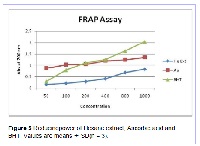In vitro antioxidant anti inflammatory and cytotoxicity activities from Hexane extract of Bryonopsis laciniosa fruits.
Keywords:
Bryonopsis laciniosa fruits, antioxidant, anti inflammatory activity, cytotoxicityAbstract
Bryonopsis laciniosa also known as “Shivlingi” annual climber with bright red fruits and is reported to be highly medicinal in India. As a folk medicine, the plant is used in treatment of broad range of diseases and disorders. In the present study, Hexane extract of B. laciniosa fruits were used to evaluate in vitro anti inflammatory, antioxidant and Cytotoxicity (towards MCF-7 cell line) activities. In vitro anti inflammatory activity by inhibition of protein denaturation, antioxidant assays like DPPH, ABTS, H2O2 and FRAP were used to measure the antioxidant capacity of the hexane extracts and cytotoxicity activity using MCF-7 breast cancer cell line. Hexane extract showed the effective antioxidant activity in all assays compared to ascorbic acid and BHT. The results for In vitro anti inflammatory activity of hexane extract and Dichlofenac drug were equivalent, hexane extract showed promising activity for inhibition of protein denaturation assay. The cytotoxicity activity from hexane extract was noticeable against MCF-7 cell line. The overall results show potential application of Bryonopsis laciniosa fruits suggesting their potential application as a health-promoting functional ingredient or natural preservative in foods.
References
Ferreira ICFR, Abreu RMV. Stress Oxidativo, Antioxidantes e Fitoquimicos. Bioana´lise;2007(2):32–39.
Halliwell B. Antioxidants in human health and disease.
Annual Review of Nutrition; 1996.
Shekhawat N. Payal SS, Singh T, Vijayvergia R. Assessment of free radicals scavenging activity of crude extracts
of some medicinal plants. Middle-East Journal of Scientific Research;2010(5):298–301.
Valko M, Leibfritz D, Moncol J, Cronin MT, M M, Telser
J. Free radicals and antioxidants in normal physiological
functions and human disease. International Journal of Biochemistry and Cell Biology;2007(39):44–84.
Krishnaiah D. Sarbatly R, Nithyanandam R. A review of
the antioxidant potential of medicinal plant species; 2011.
Cabrera C. Artacho R, Gimenez R. Beneficial effects of
green tea – A review. Journal of the American College of
Nutrition;2006(25):79–99.
Pinto JF. Nutraceuticos e alimentos funcionais. Lidel – edicoes tecnicas, lda. Lisboa –; 2010.
KR K, BD B. In E. Blatter, et al. (Eds), Indian medicinal
plants, Vol. II, second edition. vol. Vol.; 1987. p. 1158–
II, second edition.
Thekkumalai M. Ramya Bashyam , Velavan Sivanandham. Evaluation of Phytoconstituents of Bryonopsis laciniosa fruit by UV-Visible Spectroscopy and FTIR analysis.
Pharmacognosy Journal;2015(7):165–170.
Chandra S. Priyanka Chatterjee, Protapaditya Dey, Sanjib
Bhattacharya. Evaluation of in vitro anti inflammatory activity of coffee against the denaturation of protein. Asian
Pacific Journal of Tropical Biomedicine;2012:178–180.
Braca A, Sortino C, Politi M. Antioxidant activity
of flavonoids from Licania licaniae flora. Journal of
Ethnopharmacology;2002(79):379–381.
Thoo Yin Yin, Faridah Abas, Oi-Ming Lai, Chun Wai Ho,
Jie Yin, Rikke VH, Leif HS, Chin Ping Tan. Antioxidant
synergism between ethanolic Centella asiatica extracts and
a-tocopherol in model systems. Food Chemistry; 2013.
Surveswaran S. Cai YZ, Corke H, Sun M. Systematic evaluation of natural phenolic antioxidants from 133 Indian
medicinal plants. Food Chemistry; 2007.
Oyaizu M. Studies of products of browning reaction: antioxidative activities of products of browning reaction prepared from glucosamine. Japanese Journal of Nutrition.
;p. 44–307.
Jungmin O, Jo H. Ah Reum Cho, Sung-Jin Kim, Jaejoon
Han. Antioxidant and antimicrobial activities of various
leafy herbal teas. Food Control;2013(31):403–409.
Cetinkaya Y, Gocer H, Menzek A, Gulcin I. Synthesis
and antioxidant properties of (3,4 dihydroxyphenyl)(2,3,4-
trihydroxyphenyl) methanone and its derivatives. Archiv
der Pharmazie;2012(345):323–334.
Francis D, Rita L. Rapid colorimetric assay for cell growth
and survival modifications to the tetrazolium dye procedure giving improved sensitivity and reliability. Journal of
Immunological Methods. 1986; 89–271.
Opie EL. On the relation of necrosis and inflammation to denaturation of proteins. Journal of Experimental
Medicine;1962:115–597.
Umapathy E, Ndebia EJ, Meeme A, Adam B, Menziwa P,
Nkeh-Chungag BN, Iputo JE. An experimental evaluation
of Albuca setosa aqueous extract on membrane stabilization, protein denaturation and white blood cell migration
during acute inflammation. Journal of Medicinal Plants
Research;2010(4):789–795.
Niki E, Noguchi N. Evaluation of antioxidant capacity.
What capacity is being measured by which method? International Union of Biochemistry and Molecular Biology
Life;2000:50–323.
Leong LP, Shui G. An investigation of antioxidant capacity of fruits in Singapore markets. Food
Chemistry;2002(76):69–75.
Meir S, Kanner J. Akiri B, Hadas SP. Determination and
involvement of aqueous reducing compounds in oxidative
defense systems of various senescing leaves. Journal of
Agricultural Food Chemistry. 1995; 43–1813.



